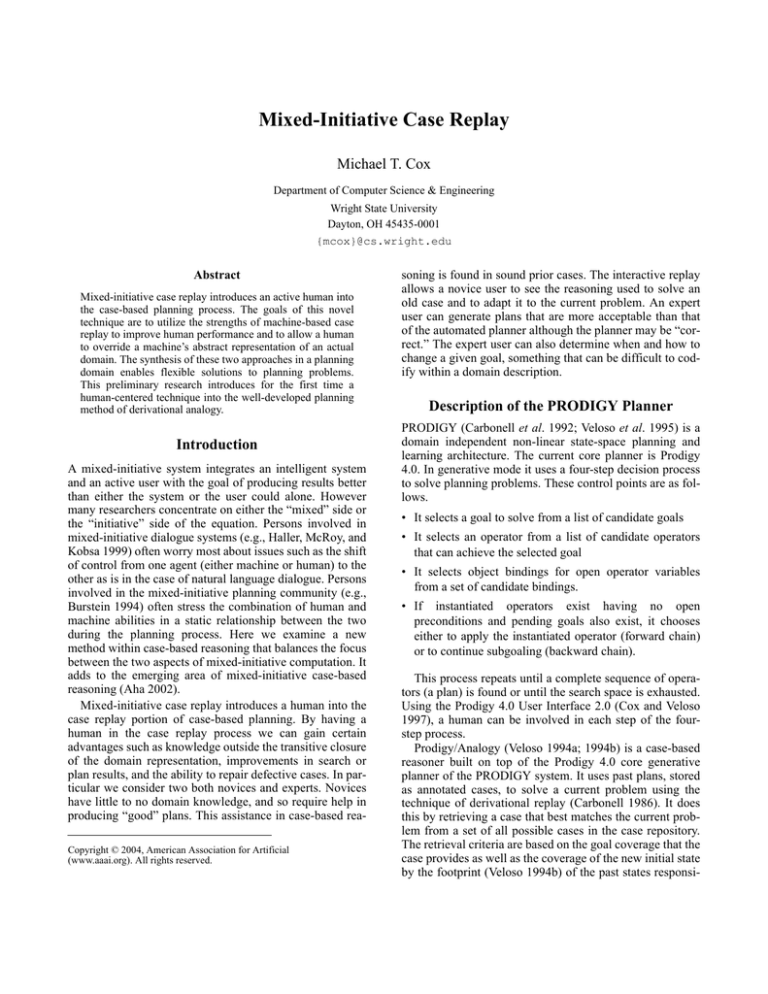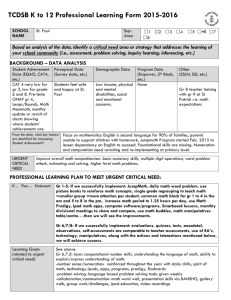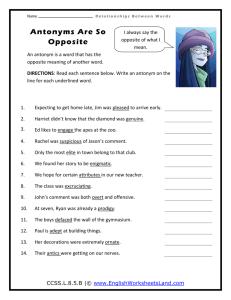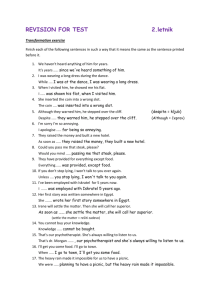
Mixed-Initiative Case Replay
Michael T. Cox
Department of Computer Science & Engineering
Wright State University
Dayton, OH 45435-0001
{mcox}@cs.wright.edu
Abstract
Mixed-initiative case replay introduces an active human into
the case-based planning process. The goals of this novel
technique are to utilize the strengths of machine-based case
replay to improve human performance and to allow a human
to override a machine’s abstract representation of an actual
domain. The synthesis of these two approaches in a planning
domain enables flexible solutions to planning problems.
This preliminary research introduces for the first time a
human-centered technique into the well-developed planning
method of derivational analogy.
Introduction
A mixed-initiative system integrates an intelligent system
and an active user with the goal of producing results better
than either the system or the user could alone. However
many researchers concentrate on either the “mixed” side or
the “initiative” side of the equation. Persons involved in
mixed-initiative dialogue systems (e.g., Haller, McRoy, and
Kobsa 1999) often worry most about issues such as the shift
of control from one agent (either machine or human) to the
other as is in the case of natural language dialogue. Persons
involved in the mixed-initiative planning community (e.g.,
Burstein 1994) often stress the combination of human and
machine abilities in a static relationship between the two
during the planning process. Here we examine a new
method within case-based reasoning that balances the focus
between the two aspects of mixed-initiative computation. It
adds to the emerging area of mixed-initiative case-based
reasoning (Aha 2002).
Mixed-initiative case replay introduces a human into the
case replay portion of case-based planning. By having a
human in the case replay process we can gain certain
advantages such as knowledge outside the transitive closure
of the domain representation, improvements in search or
plan results, and the ability to repair defective cases. In particular we consider two both novices and experts. Novices
have little to no domain knowledge, and so require help in
producing “good” plans. This assistance in case-based reaCopyright © 2004, American Association for Artificial
(www.aaai.org). All rights reserved.
soning is found in sound prior cases. The interactive replay
allows a novice user to see the reasoning used to solve an
old case and to adapt it to the current problem. An expert
user can generate plans that are more acceptable than that
of the automated planner although the planner may be “correct.” The expert user can also determine when and how to
change a given goal, something that can be difficult to codify within a domain description.
Description of the PRODIGY Planner
PRODIGY (Carbonell et al. 1992; Veloso et al. 1995) is a
domain independent non-linear state-space planning and
learning architecture. The current core planner is Prodigy
4.0. In generative mode it uses a four-step decision process
to solve planning problems. These control points are as follows.
• It selects a goal to solve from a list of candidate goals
• It selects an operator from a list of candidate operators
that can achieve the selected goal
• It selects object bindings for open operator variables
from a set of candidate bindings.
• If instantiated operators exist having no open
preconditions and pending goals also exist, it chooses
either to apply the instantiated operator (forward chain)
or to continue subgoaling (backward chain).
This process repeats until a complete sequence of operators (a plan) is found or until the search space is exhausted.
Using the Prodigy 4.0 User Interface 2.0 (Cox and Veloso
1997), a human can be involved in each step of the fourstep process.
Prodigy/Analogy (Veloso 1994a; 1994b) is a case-based
reasoner built on top of the Prodigy 4.0 core generative
planner of the PRODIGY system. It uses past plans, stored
as annotated cases, to solve a current problem using the
technique of derivational replay (Carbonell 1986). It does
this by retrieving a case that best matches the current problem from a set of all possible cases in the case repository.
The retrieval criteria are based on the goal coverage that the
case provides as well as the coverage of the new initial state
by the footprint (Veloso 1994b) of the past states responsi-
ble for the past success. Once a case is retrieved, Prodigy/
Analogy replays the past case by re-using the search tree
created in the past solution. But derivational replay also
checks the annotated justifications of the past plan (i.e., the
plan derivation) to guarantee that the previous conditions
responsible for success still hold.
Object bindings are rectified using a substitution set to
match the current problem. Substitution takes the objects
and goals defined in an old problem and maps them to
objects and goals in the current problem. If a deviation
from the case is necessary (perhaps because an operator or
state is not valid in the current problem), Prodigy/Analogy
can prune irrelevant steps and add new ones. If a case must
be abandoned, the system will switch to a generative mode
to finalize the planning process.
The introduction of mixed-initiative case replay into
Prodigy/Analogy required many changes. We modified
Prodigy 4.0 to more fully support tracking of user interaction in plan generation and case storage. We also modified
Prodigy/Analogy to include user interaction in the replay of
cases. In particular when the user selects a goal binding or
operator, an annotation is made in the search node that user
interaction occurred. The annotation also includes the particular choice that the user selected. The implementation,
called Prodigy/AnalogyMI, has also been modified to
prompt the user only on human-made operator selections
that occurred in the past case. We also modified it to enter a
generative mode that continues user interaction if casebased reasoning fails.
In generative mode with no user control, Prodigy 4.0
selects EAT-BAD-SNACK to meet the goal (see Figure 11).
This is a valid solution, but not necessarily desired or even
correct when applied to a particular user. However, the
Prodigy 4.0 User Interface Version 2.0 (Cox and Veloso
1997) allows users to interact with the automated planner,
thereby allowing a user to determine choices at three of the
four control points in the decision process described above.
In generative mode with user control, the user can select
the alternative actions EAT-GOOD-SNACK(granny-smith)
and WASH(granny-smith) with the granny-smith apple as
an operator variable binding. This produces a satisfactory
plan for the user at the current time. Perhaps the user
wanted a healthy snack, and decided a quick snack would
be to eat a washed apple. This plan is now stored as an old
case in the plan library. In this instance, the user applied
knowledge that is outside the transitive closure of the
domain representation to the solution of the problem. This
information yields a plan that more accurately reflects the
idiosyncratic desire for healthy nutrition.
Mixed-Initiative Case Replay
To illustrate mixed-initiative case replay, consider a user
solving a simple problem in a kitchen domain. In this
domain a variety of everyday actions can occur such as preparing and eating food, washing dishes, and storing/removing items from cabinets. Consider a problem in which an
agent (Seamus) is hungry and wants to be made full. Two
operators exist that can achieve this goal: EAT-BADSNACK or EAT-GOOD-SNACK. The domain associates
multiple potential bindings with each operator variable, but
it incudes constraints to filter the candidates. EAT-BADSNACK uses any available junk-food object, and eat-goodsnack uses any available fruit object. EAT-GOOD-SNACK
requires an extra operator to be used to satisfy its preconditions (slicing, washing, or peeling fruit). A sizeable search
space can exist for problems with even a single goal when
numerous binding choices are considered. Moreover, determining criteria for operator selections is not a trivial task,
and in this particular case, may be impossible to determine
with any degree of certainty before planning commences. It
is impossible to know whether to use EAT-GOOD-SNACK
or EAT-BAD-SNACK, because this is a choice that
requires much knowledge about the problem. This knowledge is best added by the user implicitly, rather than explicitly building an overly complex domain to solve a relatively
simple problem. It is therefore desirable to have a human
involved in the planning process because the domain is subject to interpretation.
Figure 1. Plan created generatively, no user interaction
As noted above, the standard PRODIGY user-interface
allows user interaction during generative mode, but does
not during case replay. Normally Prodigy/Analogy would
retrieve an old case such as the one created to eat the
granny-smith, and if the old justification for choosing a step
such as WASH still exists, then it will automatically repeat
the step, even if other steps might be more attractive given
a new situation or changing tastes. But instead of automatic
replay, Prodigy/AnalogyMI allows user intervention
throughout the derivational case-adaptation process. This
differs from the standard case replay in that the user is
1.Figures 1 through 3 are snapshots from PRODIGY’s user interface. The
graphs are goal-subgoal graphs. Blue nodes represent goal states, whereas
black nodes represent operators. Red numbers indicate that the instantiated
operator has been applied to the state, and the number itself corresponds to
the plan step number.
Figure 2. Mixed-initiative case replay: The user can choose to
reuse case guidance or make another selection.
prompted at points within the old case where user interaction previously occurred and at new points where user
interaction is currently possible that was not possible in the
past.
In the old case, the user selected EAT-GOOD-SNACK
and WASH as operators, but under mixed-initiative replay,
the user is prompted at these points to allow reconsideration. During replay the user is prompted to select an operator to achieve the goal full(Seamus). The user decides to
follow the case guidance and selects the operator EATGOOD-SNACK, so the case replay continues. Had the user
selected another operator (e.g., EAT-BAD-SNACK), the
case would no longer be valid because Prodigy/AnalogyMI
is now using a different branch of the search tree than the
one recorded in the case. Prodigy/AnalogyMI would then
switch to generative mode (with user-interaction) to continue with plan generation.
But having chosen to replay the EAT-GOOD-SNACK
action, the user now must choose an action to prepare the
apple (see Figure 2). The user could choose to follow the
guidance and wash the apple, or the user could deviate from
the plan by slicing or peeling the fruit. Perhaps the user
selects SLICE as the operator to fulfill the goal of preparing
the apple. This deviation causes Prodigy/AnalogyMI to
then enter generative mode, however, so no more choices
are necessary to meet the goals generated by selecting the
slice operator. The resulting plan can be seen in Figure 3 on
the next page.
Humans can be very good at pruning search trees. This
may not seem intuitive at first, but consider a simple problem from the logistics domain (Veloso 1994b). This domain
involves moving packages from one post office in a city to
another post office in a different city. When Prodigy 4.0 is
presented with a problem involving one package, it examines 68 nodes. Increasing the number of packages to two, it
now examines 152 nodes. A human solving the same task
in generative mode examines 48 nodes, and then 72 nodes.
This reduction in the size of the search tree occurs, because
a human can spot obvious good selections for goal ordering
(loading a truck with both packages, and then transporting
them, for instance) and binding choices. These choices are
easy for a human to make, but are often difficult to codify
into control or inference rules in the domain and become
more difficult the more detailed the domain becomes. Obviously the human will only do well in domains with which
they are relatively familiar. They need to have an understanding of how to solve the problems before they can
become better (faster, more flexible) at generating plans.
Prodigy/AnalogyMI with mixed-initiative case replay
solves the one package problem by examining only 48
nodes (the same as the human), and 97 nodes when solving
the two package problem.
Figure 3. The final plan using mixed-initiative replay and generative planning
The Bridges Problem
More complex domains present different problems to the
user and to Prodigy/Analogy. The Bridges Problem (Cox
and Veloso 1998; Cox, Kerkez, Srinivas, Edwin, and
Archer 2000) represents universally quantified planning
tasks in a military domain. The goal of this class of problems is to maximize the “barriability” of rivers by destroying or damaging all bridges across them. Air units can
destroy a single bridge and damage an arbitrary number of
others. This domain includes many more operators, variables, and choices than does the simple kitchen domain.
Prodigy/Analogy’s case retrieval process uses an interactively-footprint similarity matching algorithm (Veloso
1994a) to generate variable substitutions that map old cases
to new problems. This allows both versions of Prodigy/
Analogy to reason during case replay with the old plan
using the resources available in the new problem. However,
substitutions are not guaranteed to be optimal and can actually result in solutions that are impossible to replay automatically. For example an old case may include a solution
that achieves an impassable river by destroying four
bridges across it. A new problem may require that two rivers, one with three bridges and the other with two, be made
impassable. The match algorithm might mistakenly map
the extraneous fourth bridge in the old case to a bridge that
crosses the second river in the new problem (i.e., the one
that has two bridges). This results in a faulty case replay,
because the scope of the universally quantified precondition for destroying a bridge restricts the operator variables
to bridges across a single river. In our example the mismapped bridge crosses a second river instead. Thus Prodigy/AnalogyMI searches for an operator to move the bridge
to the river with three bridges, but no such operator exists
in the domain. Humans easily understand that suspension
bridges cannot be moved between rivers and can reject the
past case altogether. The user can then create a new solution from scratch.
Humans can improve upon case replay behavior in other
ways. The system prompts the user for a decision based on
old cases. When it uses cases that were generated by a novice user, the machine cannot suggest optimal solutions from
naive experience. While these suggestions will hopefully
lead to a solution, they will not necessarily result in the best
solution. Novice users often choose to do the bare minimum to solve a task in the bridges problems. For example
an initial state may consist of a river, four bridges that cross
the river, and three aircraft, and the goal may be to make
the river impassable (see Figure 4a). Because not enough
resources exist to destroy all four bridges (each aircraft can
only destroy one bridge), the user must change the goal.
The user correctly performs this by selecting an operator
that allows damage as well as destruction of bridges. However, because the user is a novice, she may damage all of
the bridges instead of destroying three and damaging one
(see figure 4b).
A. Problem state
B. Novice solution
Figure 4. The bridges problem
While damaging all of the bridges does meet the requirements of restricting movement across a river, it is not an
optimal solution. When this solution is played back in the
form of a case, the user is prompted with the actions of the
novice user. In this case, Prodigy/AnalogyMI suggests that
the current user damage all of the bridges crossing the river.
A more experienced user over-rides the suggestion and
makes full use of the resources available in the problem.
If we instead examine a novice user replaying the cases
of a more experienced user, we find that Prodigy/AnalogyMI provides better advice. Assume that a domain expert
has solved the same goal transformation problem (three aircraft, four bridges) discussed previously. When the novice
user replays the case, Prodigy/Analogy suggests destroying
three of the bridges and damaging the fourth (see Figure 5).
This results in a much higher overall goal satisfaction (see
Edwin and Cox 2002 for the formal goal satisfaction criterion).
Figure 5. Using an expert’s solution
Future Work
This paper has argued that derivational analogy in general
and case-replay in particular can be improved by adding an
active human user to automated case-based planning.
Implemented examples demonstrate some of the strengths
of this argument. However, empirical results would better
support the efficacy of this approach.
Earlier research on mixed-initiative planning claims that
presenting planning to humans as a search process is less
effective than presenting it as a goal manipulation problem
(Cox 2000). Experimental results from human studies lend
support to this claim (Cox 2003; Zhang 2002). The studies
compare users’ performance solving bridges problems
under a search metaphor and the Prodigy 4.0 User Interface
2.0 with the performance subjects using a goal manipulation metaphor and a PRODIGY-based mixed-initiative
planner called GTrans (Cox 2000; Cox, Kerkez, Srinivas,
Edwin, and Archer 2000; Zhang 2002; Zhang, Cox, and
Immaneni 2002).
We have begun to examine the results from this study for
the users under the search condition. We have their performance figures for the problems that they solved with
PRODIGY under the user-control mode. That is, users
themselves made the planning decisions at the control
points enumerated in section two. But consider the potential performance difference if mixed-initiative case replay
had augmented user choices. If the system had saved each
solution as a case during the experiment, Prodigy/AnalogyMI could have retrieved problems they has already
solved to provide guidance in subsequent test problems.
Manual examination of a small sample of the data show
mixed results. In some instances mixed-initiative case
replay would have produced better performance and in others it would have resulted in worse performance. The problem with this preliminary analysis is that we only estimate
the experimental results by assuming that all test subjects
would follow the case guidance without question. Yet this
paper has shown that many examples exist where humans
can improve over the suggested choices. A future experimental study with new human subjects can reveal a more
complete and accurate understanding of these phenomena.
Conclusions
Both Prodigy 4.0 and Prodigy/Analogy generate plans that
are correct, but they may not order operations in an efficient
manner. Furthermore plans may be longer than necessary
(e.g., moving a plane back and forth to move several packages instead of loading all packages at once). Humans can
provide information that is outside the transitive closure of
the domain representations in PRODIGY and thus reduce
the amount of domain engineering. Moreover a smaller and
more abstract domain theory leads to more efficient planning. This is also useful, because it is generally very difficult to describe operators in such a way that they mimic the
subtle variations and requirements found in the real world.
Domains can also contain situations that are interpreted differently by different users. An example we have used here
is the individual preference between eating nutritious or
tasty snacks.
The scientific goal to design fully autonomous, general
planning systems has all but disappeared from the artificial
intelligence community. Instead the field has continued in
two broad research directions. The first is to constrain the
computational definition of a planning problem and its representation so that new search methods can efficiently pro-
duce solutions. Many approaches using boolean
satisfiability representations of plans follow this direction.
One large problem, however, is that users of such systems
are even more divided from the underlying technology and
therefore less likely to be involved in its decision making.
The second research direction is toward more understandable and human centered systems. The concept of
mixed-initiative computation emphasizes the synergy possible between humans and intelligent machines. This paper
has introduced a new technique for case-based planning
that examines active user participation as a potential
method for escaping some computational limitations and
for producing quality results using human experience with
both the planning domain and with interaction with the system itself.
Acknowledgments
This research is funded in part through a grant from Science
Applications International Corporation (SAIC) and a
research challenge grant from Wright State University. The
author thanks Seamus Sullivan for his hard work on implementing the changes to Prodigy/Analogy. I also thank
Kevin Cleereman and the four anonymous reviewers for
their helpful suggestions.
Cox, M. T.; Kerkez, B.; Srinivas, C.; Edwin, G.; and
Archer, W. 2000. Toward agent-based mixed-initiative
interfaces. In H. R. Arabnia ed., Proceedings of the 2000
International Conference on Artificial Intelligence, Vol. 1,
309-315. CSREA Press.
Cox, M. T.; and Veloso, M. M. 1998. Goal Transformations
in Continuous Planning. In M. desJardins ed., Proceedings
of the 1998 AAAI Fall Symposium on Distributed Continual
Planning, 23-30. Menlo Park, CA: AAAI Press / The MIT
Press.
Cox, M. T.; and Veloso, M. M. 1997. Supporting combined
human and machine planning: An interface for planning by
analogical reasoning. In D. B. Leake and E. Plaza eds.,
Case-Based Reasoning Research and Development: Second
International Conference on Case-Based Reasoning, 531540. Berlin: Springer-Verlag.
Edwin, G., and Cox, M. T. 2001. Resource Coordination in
Single Agent and Multiagent Systems. In Proceedings of
the 13th IEEE International Conference on Tools with Artificial Intelligence, 18-24. Los Alamitos, CA: IEEE Computer Society.
Haller, S.; McRoy, S.; and Kobsa, A. eds. 1999. Computational models of mixed-initiative interaction. Boston: Kluwer.
References
Veloso, M. M., 1994a. Planning and Learning by Analogical Reasoning. Berlin: Spring-Verlag.
Aha, D. ed. 2002. Proceedings of the Workshop on Mixedinitiative Case-Based Reasoning at the Sixth European
Conference on Case-Based Reasoning.
Veloso, M. M. 1994b. Prodigy/Analogy: Analogical Reasoning in General Problem Solving. In Topics in CaseBased Reasoning, S. Wess, K.-D. Althoff, and M. Richter
eds., Berlin: Springer Verlag, 33-50.
Burstein, M. ed. 1994. Proceedings of the ARPA / Rome
Laboratory Knowledge-Based Planning and Scheduling
Initiative. San Francisco: Morgan Kaufmann.
Carbonell, J. G. 1986. Derivational Analogy: A theory of
reconstructive problem solving and expertise acquisition.
In R. Michalski, J. Carbonell and T. Mitchell eds., Machine
learning: An artificial intelligence approach, Vol. 2, 371392. San Mateo, CA: Morgan Kaufmann Publishers.
Carbonell, J. G.; Blythe, J.; Etzioni, O.; Gil, Y.; Joseph, R.;
Kahn, D.; Knoblock, C.; Minton, S.; Perez, A.; Reilly, S.;
Veloso, M. M.; and Wang, X. 1992. PRODIGY4.0: The
Manual and Tutorial, Technical Report, Computer Science
Department, Carnegie Mellon University.
Cox, M. T. 2003. Planning as Mixed-initiative Goal manipulation. In G. Tecuci, D. Aha, M. Boicu, M. T. Cox, G. Ferguson, and A. Tate eds., Proceedings of the Workshop on
Mixed-Initiative Intelligent Systems at the 18th International Joint Conference on Artificial Intelligence, 36-41.
Menlo Park, CA: International Joint Conference on Artificial Intelligence, Inc.
Cox, M. T. 2000. A Conflict of Metaphors: Modeling the
planning process. In Proceedings of the 2000 Summer
Computer Simulation Conference, 666-671. San Diego:
The Society for Computer Simulation International.
Veloso, M. M.; Carbonell, J.; Perez, A.; Borrajo, D.; Fink,
E.; and Blythe, J. 1995. Integrating planning and learning:
The PRODIGY Architecture. Journal of Theoretical and
Experimental Artificial Intelligence 7.
Zhang, C. 2002. Cognitive models for mixed-initiative
planning. Masters dissertation, Wright State University,
Computer Science and Engineering Department, Dayton,
OH. (Available at URL www.cs.wright.edu/
~mcox/GTrans/zhang2002.pdf)
Zhang, C.; Cox, M. T.; and Immaneni, T. 2002. GTrans version 2.1 User manual and reference, Technical Report,
WSU-CS-02-02. Dayton, OH: Wright State University,
Department of Computer Science and Engineering.






